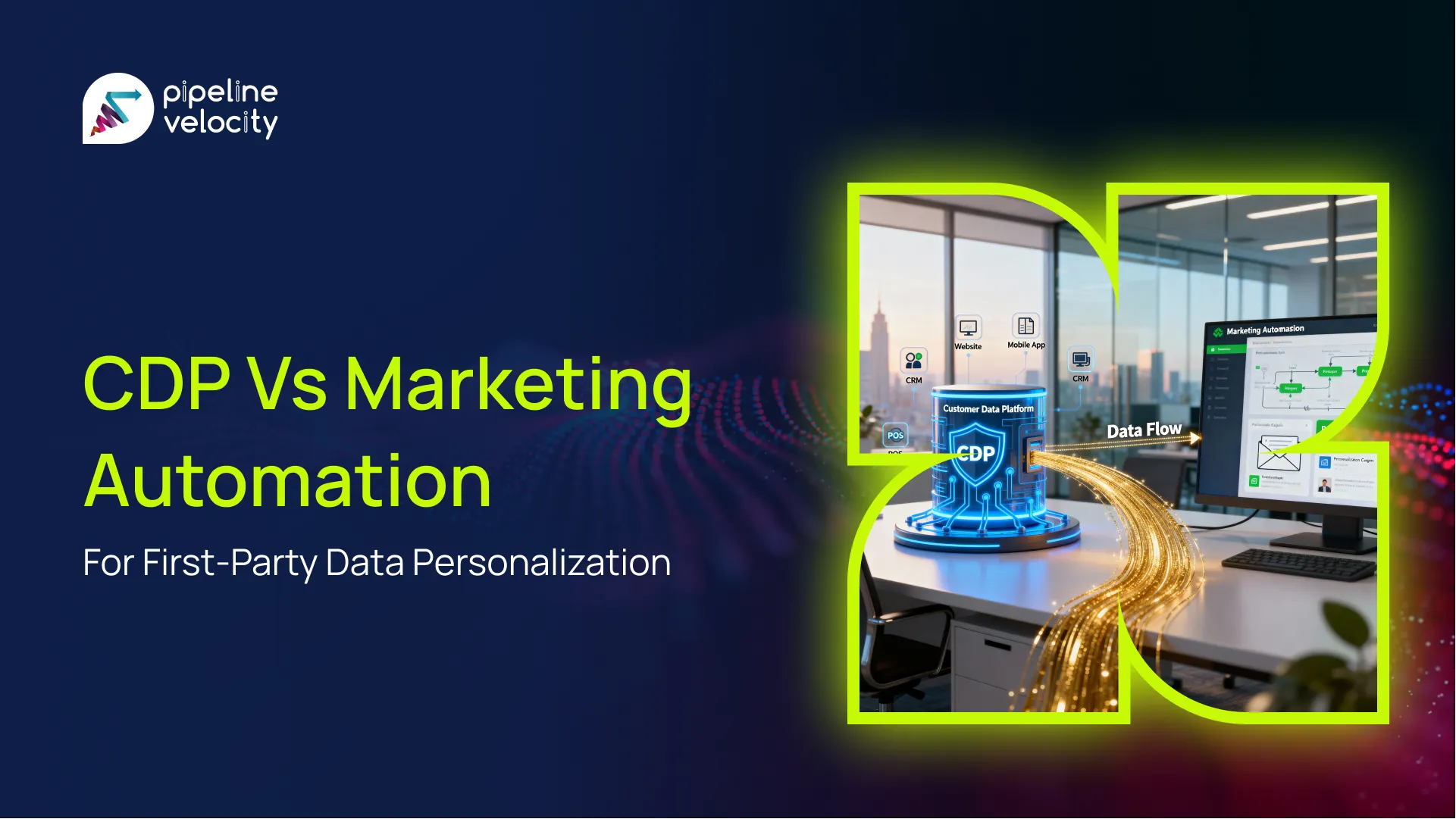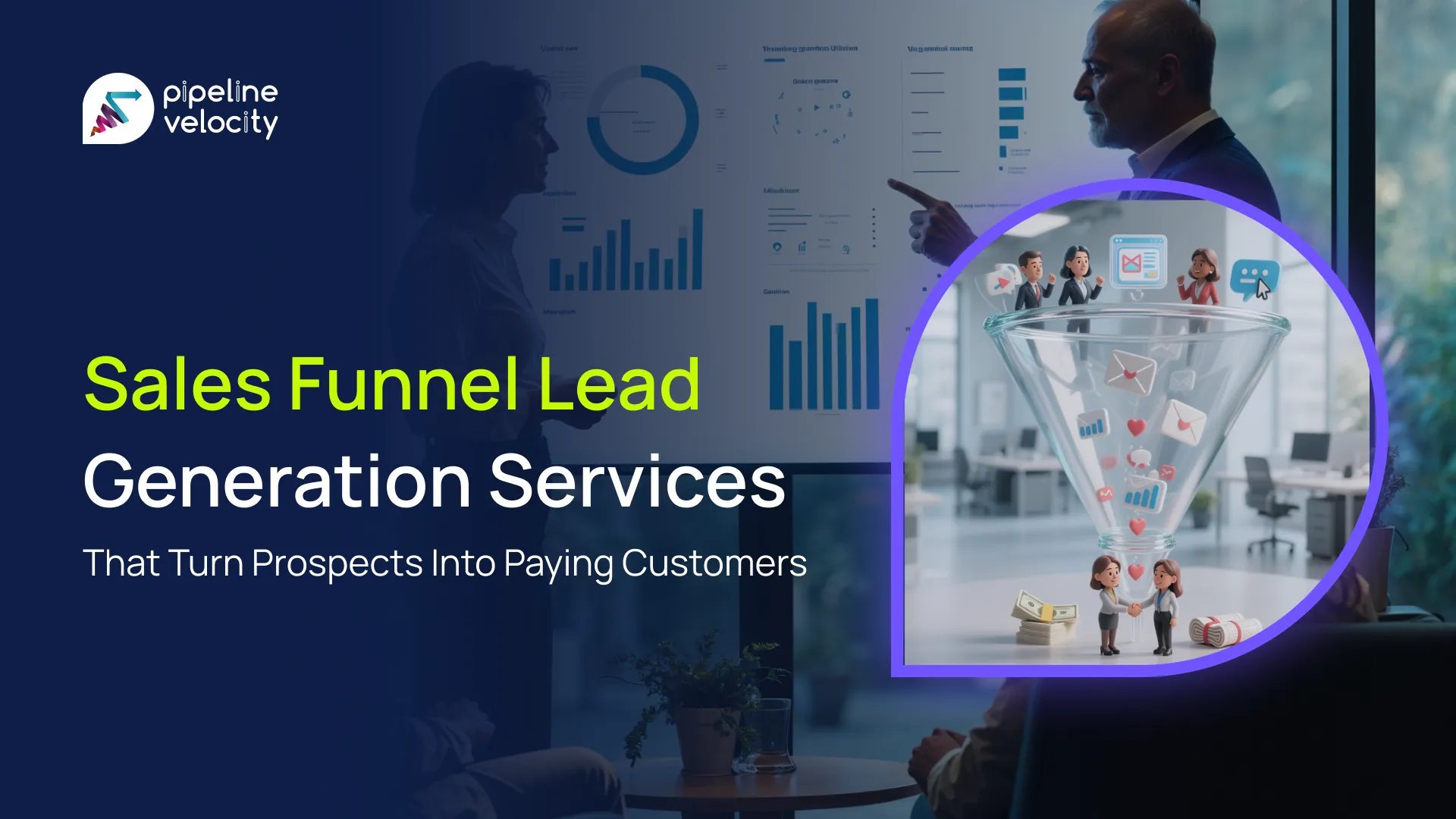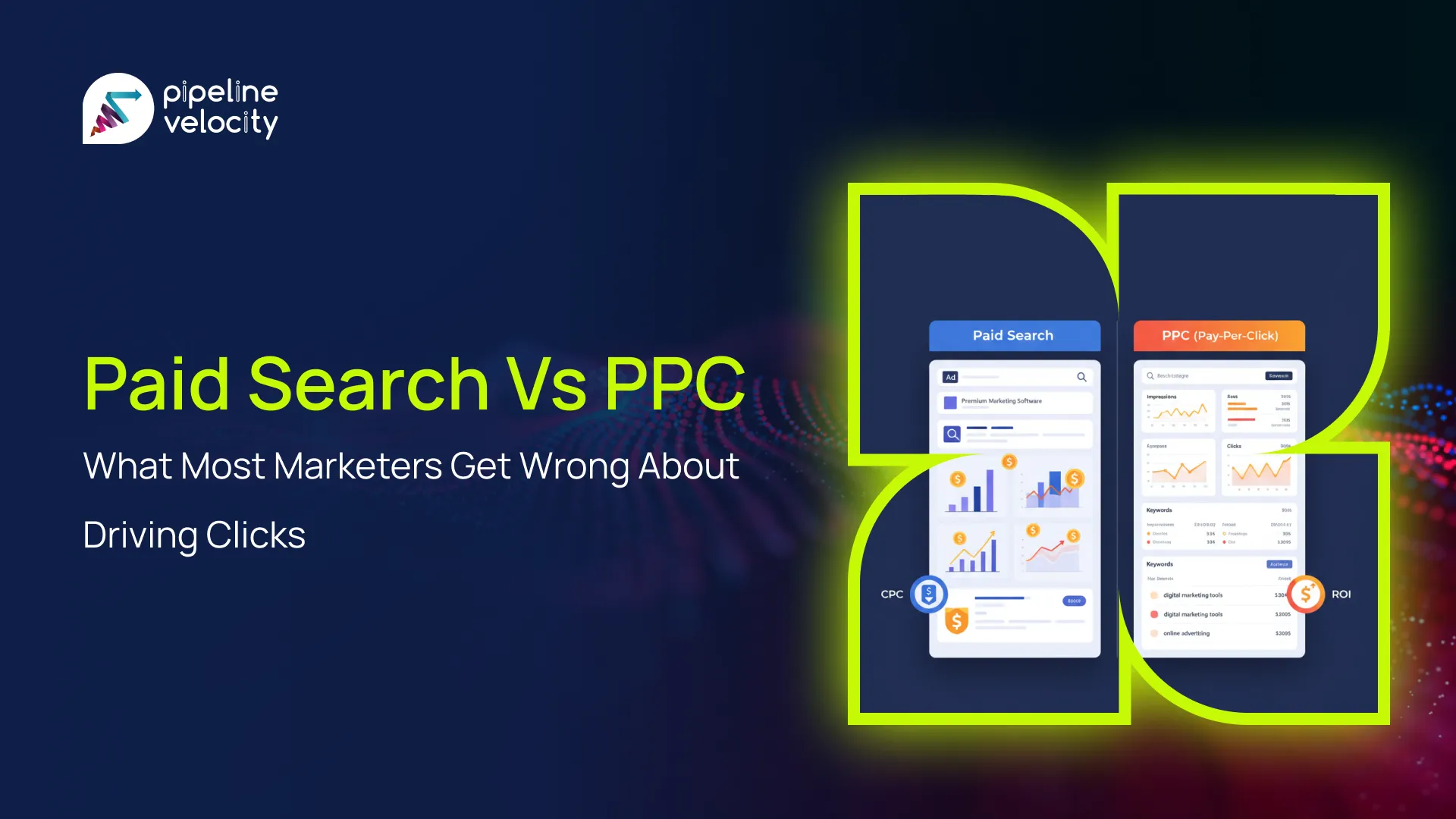CDP vs marketing automation comes down to data foundation versus message execution. A Customer Data Platform builds a single Customer View CDPS layer from every Website interaction, Email Address, and CRM System touchpoint so a Marketer can target with confidence. A Marketing Automation Platform powers Email Campaign sends, Email Nurturing, Automation Workflows, and retargeting messages across Channels with measurable Marketing ROI. Use a CDP when Data Needs include identity, Data Integration, and Real-Time Analytics for Audience Segmentation. Use marketing automation when Marketing Workflows, Email Marketing, and Marketing Campaign Automation drive the next conversion. Most teams connect both so Customer Data collection feeds better Marketing Execution, and better campaigns feed richer Customer Data.
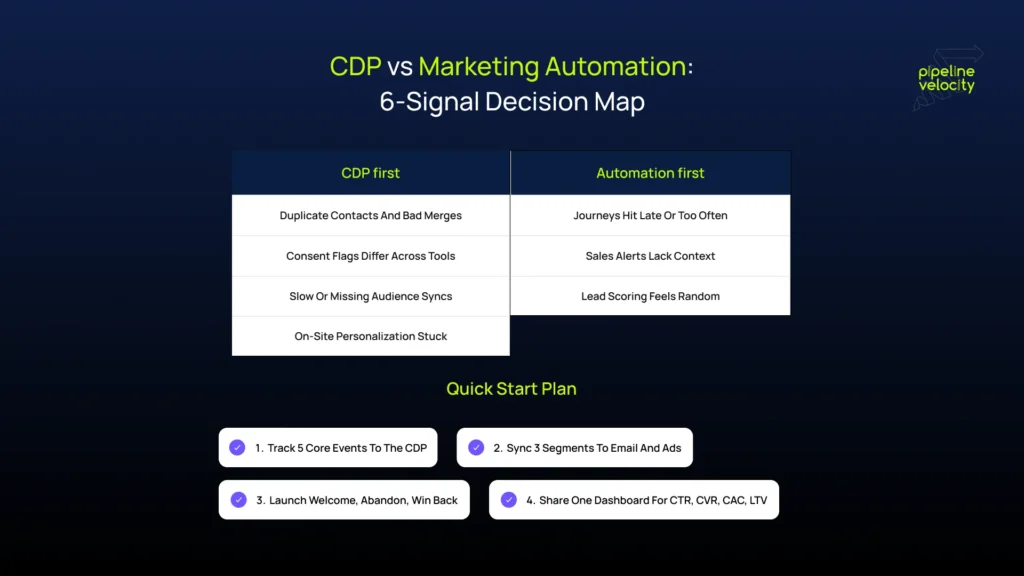
Quick primer on CDP vs marketing automation
A quick primer sets the stakes and clarifies differences a Marketer cares about. A Customer Data Platform focuses on Customer Data Management, Data Processing, and Data Storage so profiles make sense across Data Sources. A Marketing Automation Solution focuses on messages, journeys, and Email Sequences so prospects advance through the Buying Journey. You will see how Segmentation, Data Insights, and Optimization flow from a strong data layer into Email Marketing Platforms and SMS. You will also see how Website Analytics, Website Content, and Social Media Engagement data improve decisions when the stack stays in sync. Keep this lens as we compare roles, analytics, and improved outcomes section by section. For deeper context, see our take on end to end marketing solutions and how strategy ties data to execution.
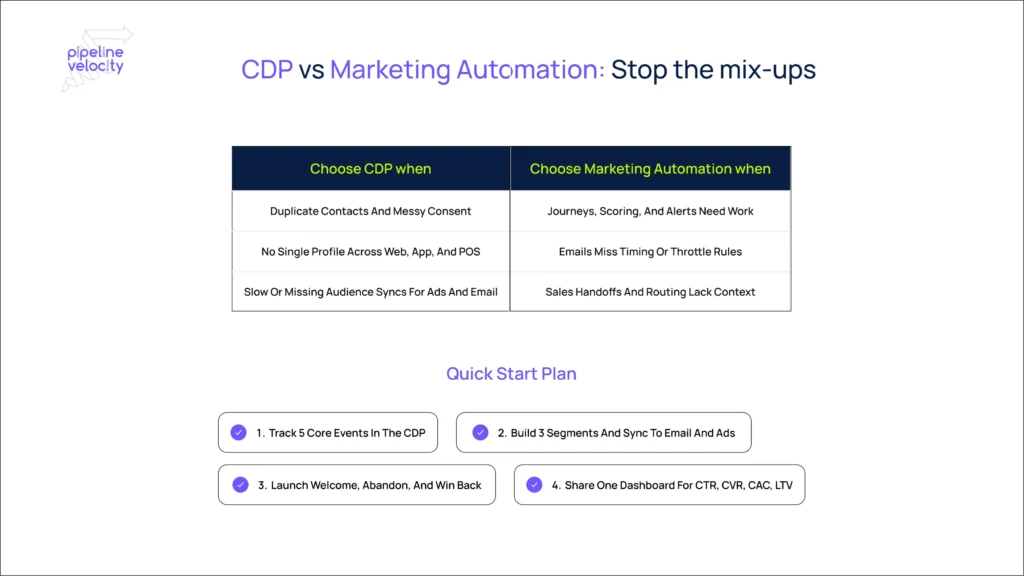
Customer data platform in plain English
A CDP collects Website Activity, app events, POS receipts, service tickets, and Browsing signals, then stitches them into profiles inside Customer Data Platforms. It runs identity across Email Address, device IDs, logins, and order numbers to deliver Customer Data Unification. It stores traits and consent in an Interface that teams understand, supports Data Syncing out to email, ads, and CRMS, and accepts returns for measurement. It gives Marketers Segmentation, Customer Segmentation Analysis, and prediction on who buys next. It serves as the trusted source for Data Management so Marketing Tech, analytics, and ad tools read the same truth.
Marketing automation platform in plain English
A Marketing Automation Platform sends the right Email Campaign or SMS based on rules, scores, and Behavior. It manages journeys, throttles, and quiet hours, and it ships templates that any Email Marketer can use with Email Marketing Tools. It supports Lead Segmentation, Email Engagement testing, and sales handoffs to CRMS without manual exports. It powers Marketing Automation Insights on cadence, copy, and conversion while surfacing Drawbacks and gaps to fix. It turns segments into Automation Efforts that move revenue today.
Why teams confuse these two
Both handle audiences and triggers, and vendors blur the lines as they expand features. Automation added simple Website tracking while CDPS added light messaging for Campaign CDPS use cases. Teams face tight budgets and hope one tool covers all Data Needs. Clear roles stop the mix up. Let the CDP handle Customer Data Collection, Data Processing Capabilities, and Offer Greater Privacy Compliance. Let automation handle the message, Email Marketing, and sales follow ups.
Customer data platform vs automation tools at a glance
This section draws out key differences so teams choose with clarity. Think of a CDP as the data hub for Customer Database truth, while automation is the action layer for Marketing Tech Stack execution. You will see where identity, event handling, timing, and analytics separate the two. You will also see how improved Segmentation and Analytics raise Engagement Rates. Use these contrasts to build a Tech Stack that scales without silos.
Data unification vs campaign execution
A CDP unifies profiles from Data Sources like Website, app, POS, CRMS, and support into one Customer View CDPS record. Automation turns that record into Email Campaign sends, SMS, and in app prompts. The CDP improves match rates, audience freshness, and Data Insights. The automation layer converts those insights into Marketing Workflows that welcome, nurture, cross sell, and win back. Together they lift Productivity and reduce silos.
Identity resolution vs lead scoring
A CDP runs deterministic and probabilistic links across logins, cookies, and Email Address fields. It manages account or household joins and keeps a full timeline for Decision Making. The automation layer turns Behavior and fit into lead scores that sales trusts. It routes hot contacts to the right rep and tracks follow ups for improved Lead Quality Marketing Automation outcomes. Use the CDP for identity truth and automation for action.
Event streaming vs batch lists
A CDP ingests streams in near real time and updates profiles as Website Visits and Website Interactions happen. Automation often relies on lists that refresh on schedules, which works for newsletters and promos. When speed matters, the CDP pushes trigger signals to Email Marketing Platforms within minutes. When scale matters, automation sends to large lists on a calendar. Pick speed or scale based on the moment.
Real time profiles vs scheduled sends
A CDP maintains live profiles that adjust with every click or support note. Automation lines up scheduled sends that respect quiet hours and frequency caps. Real time wins for cart recovery, price drop alerts, and on site personalization in E-Commerce. Scheduled wins for monthly roundups and nurture lanes. Blend both for steady reach and timely triggers.
How Pipeline Velocity accelerates data into action
Our services at Pipeline Velocity connect your CDP and marketing automation so data turns into revenue without busywork. We design growth systems that join identity, segmentation, and Marketing Campaign Automation, then we measure lift end to end. Explore our growth marketing services to shape the right Marketing Technology Stack, our SEO services to expand qualified demand that feeds your Customer Database, and our PPC management to capture high intent while your Automation Workflows convert it. For cross channel consistency, our omnichannel marketing aligns Customer Data, creative, and cadence so every send and ad reflects the same profile truth.
When a CDP drives better engagement
This section shows where Customer Data Platforms deliver improved outcomes fast. You will see patterns that raise Engagement Rates, cut waste, and Drive Loyalty. These wins appear across Retail Brand, travel, SaaS, media, and fintech with small tweaks. Use them to plan events, traits, and consent from day one. Strong inputs power strong activation.
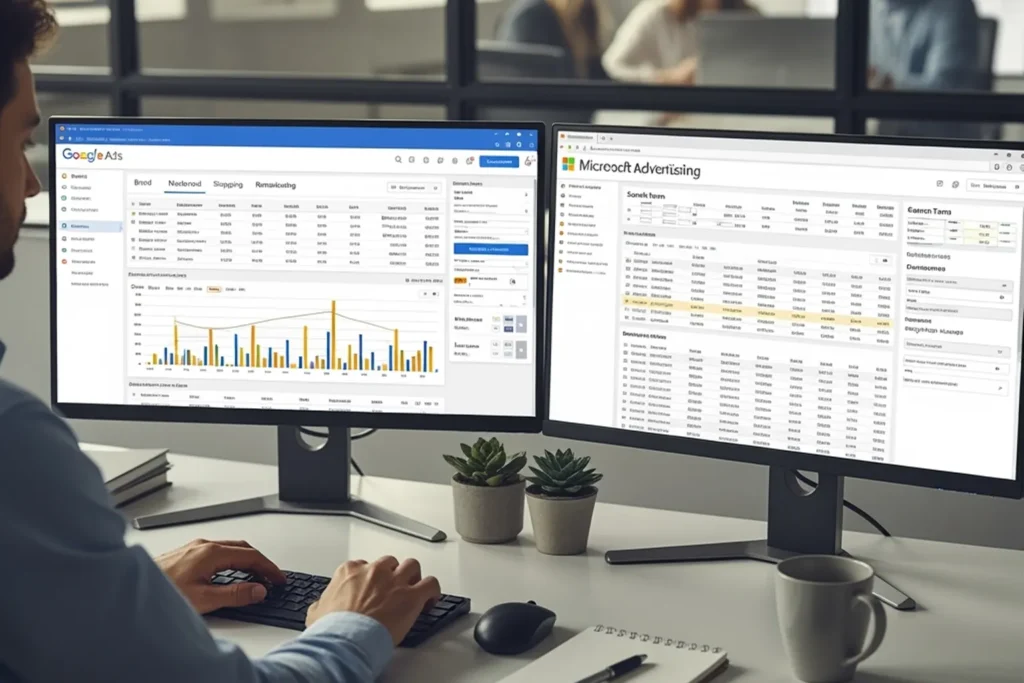
Personalization at scale across channels
Build one segment in the CDP and use it across Email Marketing Platforms, ads, push, and web without rebuilds. Share traits such as last product viewed, AOV, churn risk, and consent so creative stays relevant. Sync suppression to stop paid reach after conversion and lift Marketing ROI. Use Audience Segmentation to reuse logic for seasonal or category programs. Better data makes every Channel smarter.
Omnichannel journeys that react to behavior
Shift prospects between paths based on Website Activity, cart status, service tags, or store visits within minutes. Pause, swap, or boost sends as intent changes so content tracks the Buying Journey. Feed outcomes back to the CDP to improve Segmentation and prediction. Add Retargeting Messages for high intent browsers and mirror that logic in email and ads. Customers feel understood and act faster.
Privacy-first audience building with consent
Centralize consent flags by purpose, scope, and region so every Channel respects them. Honor opt outs across email, SMS, push, and ad audiences to protect reach and brand. Store reasons like unsubscribed, complaint, or hard bounce and share them across CRMS and ad tools. CDPS with strong governance Offer Greater Privacy Compliance that legal teams support. Clean consent lowers complaints and preserves deliverability.
When marketing automation drives better results
This section highlights where a Marketing Automation Software stack shines. You will see how journeys, scoring, and alerts pay off without heavy engineering. These strengths matter to teams with strong copy and a clear content calendar. They also matter to small teams that need speed and control in one place. Lean into these wins while your data layer matures.
Lifecycle email and SMS made simple
Automation ships prebuilt flows for welcome, onboarding, win back, and post purchase care. Editors make testing fast for any Email Marketer using Email Marketing Tools such as Mail Chimp or HubSpot. Guardrails keep frequency and quiet hours in check while templates keep brand style tight. Deliverability tools surface issues early so Email Engagement improves. Simple, repeatable Marketing Workflows build steady revenue.
Lead nurturing and scoring for B2B
Turn unknown traffic into known leads, then warm them with content mapped to Lead Segmentation. Score actions like demo views, webinar attendance, and repeat sessions, then push alerts to sales with context in the CRM System. Sync journey status and next best action so CRMS show one story across teams. Improve the score model with win and loss notes for improved conversion. Sales trusts the signal because it reflects real Behavior.
Sales alerts and routing you can trust
Fire alerts to the right owner when pricing pages, proposals, or product trials spike. Route by territory, product line, or partner rules you control in CRMS. Reps get tasks with links to exact Website Content viewed and the Email Campaign that drove it. Managers track speed to lead and outcomes by owner. Everyone moves faster because context lives in the record.
Why most brands benefit from both
A CDP and automation solve different problems and amplify each other when connected. The CDP raises data quality and Segmentation accuracy. The automation layer raises message quality, cadence, and Marketing Execution. Profiles get richer as campaigns run, which lifts the next campaign. Alignment reduces Silos and boosts Collaboration across teams.
CDP as the brain, automation as the hands
Treat the CDP as the brain that knows who each person is and what they did. Treat the automation layer as the hands that send, score, and route with precision. The brain sets eligibility, suppression, and consent while the hands craft and deliver the message. This split simplifies Decision Making Process for the Marketer Segment that owns growth. Clear roles reduce Reliance on manual lists and exports.
How data flows between the two
Events land in the CDP, which updates profiles and audiences. The CDP pushes those traits to automation in real time or on a schedule. Automation executes and sends outcomes like opens, clicks, and orders back to the CDP. The loop improves Data Insights and prediction week after week. Keep this loop tight and costs fall as results rise.
Avoiding data silos and duplicate profiles
Point identity to the CDP and let automation reference that ID. Standardize keys and turn on strict matching so duplicates do not spawn. Sync suppression and hard bounces back to the CDP so every tool respects reach rules. Document field names and semantics so teams reuse traits rather than invent new ones. Shared standards prevent Silos and rework.
Integration patterns that actually work
Connect your stack with the fewest moving parts that still meet rules and scale. You will see where native connectors beat heavy glue and where iPaaS makes sense. You will also see how event names, consent flags, and attribution tags keep Maps, dashboards, and reports accurate. Good plumbing drives faster work and fewer surprises. Aim for resilience and Scalability. For practical tips on structuring content and signals for modern discovery, read our guide to optimizing blogs for generative engines.
Native connectors vs iPaaS glue
Native connections install fast and ship opinionated field maps that work out of the box. They support bulk upserts and fewer hops. iPaaS helps when logic must sit in the middle, when tools lack direct links, or when you orchestrate across many CRMS. Start native, then add iPaaS only where needed. Fewer hops means fewer failures.
Event schema and naming that scales
Name events in plain English such as Product Viewed, Added to Cart, Checkout Started, and Order Completed. Include product ID, price, currency, and category as standard fields. Publish a schema reference the whole team can use in the Blog and wiki. Keep names stable so Website Analytics and Maps in dashboards do not break after changes. Shared names raise data quality and speed onboarding.
Consent flags and suppression rules
Store consent by purpose and channel with timestamps and source. Pass consent updates through to Email Marketing Platforms, ads, and CRMS. Track suppression reasons such as unsubscribed, complaint, and hard bounce in the CDP. Honor flags across email, SMS, push, and ads to protect reach. This habit saves money and preserves brand equity.
Attribution and closed loop reporting
Attach campaign and journey IDs to key events so reporting ties to spend. Pull order, signup, and pipeline data into the CDP for closed loop views. Feed attribution back into automation so throttles and branches learn. Share one page dashboards across marketing, sales, and finance built in Microsoft BI or Salesforce reports. When everyone sees the same math, investment grows.
How to choose: a fast checklist
A short checklist helps teams decide where to invest first. Score each item across team skills, data flow, channels, governance, and spend. The score will point to CDP, automation, or both. Buy for the next 18 months, not eight years. Keep the plan tight and the wins visible.
Team skills and bandwidth
List who owns events, identity, and Data Management today, and who owns journeys and copy. Heavy data work without the right Expertise slows deployment. Advanced journeys without a content owner stall after launch. Invest in gaps and pick tools that match skill today. Plan training so skills rise with the stack. For lean teams, this fractional marketing playbook shows how to add senior execution without full time cost.
Data sources and volume today
Inventory Website, app, POS, support, ads, and warehouse sources. Count daily events and profiles so spend matches load. High volume streams call for CDPS with strong Data Processing Capabilities and Data Storage controls. Lower volume programs can start light and focus on activation wins. Match the stack to your real traffic.
Channels that matter for growth
Write down the two or three Channels that move revenue today. If Email Marketing and SMS drive most wins, invest in Marketing Automation Technologies. If ads and on site personalization drive wins, strengthen the CDP and streaming pipes. Add social touches like Twitter replies and Maps embeds to close gaps in local flows. Focus brings faster lift.
Privacy, consent, and governance
List your regions, policies, and retention needs so tools honor them by default. Pick vendors with strong consent, audit trails, and deletion paths. Make sure you can purge across every connected tool within service thresholds. Use role based access so only the right people see PII. Good guardrails make bold programs safe.
Budget and total cost to run
Add license, implementation, ops, and team time, not just sticker price. Ask vendors about usage tiers, overage rules, and export fees. Estimate internal hours for tagging, mapping, QA, and journey testing. Compare with hours for copy, creative, and offers. Choose the mix that shows payback within two or three quarters.
Licensing, implementation, and ops costs
Licenses grow with contacts, events, retention, and channel volume. Implementation covers data mapping, identity setup, and connections. Ops includes QA, schema updates, consent sync, and deliverability. Training turns features into results. Keep a small buffer for experiments and seasonal spikes.
B2B vs B2C: what really changes
Both share the same bones, yet scale and handoffs differ. B2B demands account context, buying committees, and opportunity data in every profile. B2C demands consumer scale, SKU context, and store events that stream all day. Tune your Marketing Technology Stack to each motion while reusing shared pieces. Clean handoffs cut friction. Everyone ships faster.
Account based needs vs consumer scale
B2B needs account hierarchies, sales stages, and pipeline views tied to profiles. B2C needs household or shopper models with product history and loyalty traits. A CDP can handle both when you design for accounts or households up front. Automation should support account routing in B2B and replenishment in B2C. Treat shared workflows as shared and tune the rest.
CRM alignment and sales handoff
B2B requires precise sync between CDP, automation, and CRM System. The CDP cleans and enriches, automation nurtures and scores, and CRM owns pipeline and revenue. Handoffs must include last activity, content consumed, and buying signals. B2C still needs service handoffs for returns and loyalty. Clean context shortens cycles and lifts satisfaction.
Offline and point of sale data
Pipe POS events and kiosk interactions into the CDP with receipt and loyalty IDs. Send key offline triggers to automation for post purchase care and replenishment. Join online and offline so offers never feel off. Full journeys make promos and inventory smarter. Better data beats guesswork.
First-party data strategy you can act on
This plan builds durable first party signals. You will replace third party cookies with consented inputs and server side events. You will also collect zero party answers that shape content and cadence. The result is a resilient stack that grows on its own data. Strong collection fuels strong activation.
Life after third party cookies
Shift spend toward channels you can measure with first party data such as email, SMS, and direct. Use modeled conversions in ads while you raise match rates with CDPS. Collect events, consent, and traits so profiles get richer without weak IDs. Consider clean rooms or DMPS only when scale demands. Your own data wins the long game.
Server side tracking basics
Move critical events to server collection so blockers and browsers do not erase them. Standardize endpoints and sign requests so payloads stay trusted. Validate against schema in the CDP, then route to analytics, ads, and automation. Monitor drop rates and latency so triggers stay sharp. Server pipes keep dashboards stable.
Zero party data you should collect
Ask for preferences that shape content, cadence, and product picks, then honor them. Offer quizzes, size finders, and setup guides that trade value for detail. Store answers in the CDP as traits with timestamps and sources. Refresh after purchases or renewals. Zero party inputs beat bought lists.
Real time vs batch: speed that moves revenue
Pick speed when speed adds money and pick batch when a schedule works fine. You will set trigger windows that match intent and you will stream to the right tools. You will also keep payloads small so pipes run clean. Speed matters, control matters more. Tune both for gains.
Trigger windows that convert
Fire cart and browse triggers within minutes while intent runs hot. Use short windows for pricing views, back in stock alerts, and quotes viewed. Use longer windows for content milestones or seasonal promos. Cap frequency and add quiet hours so alerts feel helpful. Right sized windows convert without burn.
Streaming to ad and email channels
Push audiences from the CDP to ad platforms every few hours for prospecting and every few minutes for remarketing. Sync suppression across ads and email to stop paying after conversion. Send high intent traits to Email Marketing Platforms and on site tools so content matches interest. Keep fields consistent so pipes stay reliable. Faster loops lower cost per order.
90 day roadmap to value
This roadmap gets you to value in a quarter. You will stand up events, stitch identities, build segments, and activate high intent journeys. Each phase ships value and feeds the next. Keep scope tight and measure lift against a baseline. Momentum wins.
Phase 1 data audit and events
List top paths to revenue, then define five to seven events that matter most. Tag those events with a simple schema and send them to the CDP and analytics. Verify each field and confirm counts match across tools before you move on. Share a dashboard that shows volume and funnels so stakeholders see progress. With clean events live, you can build the next steps with confidence.
Phase 2 identity and segments
Turn on identity rules and test matches for email, login, and device graphs. Build core segments such as new subscriber, active browser, cart abandoner, high value buyer, and churn risk. Review sample profiles to confirm traits and timelines make sense. Share definitions with marketing, sales, and service so everyone uses the same names. Good segments become the building blocks for every journey.
Phase 3 activation in email and ads
Connect the CDP to your automation platform and to top ad platforms. Launch three journeys that hit clear intent: welcome, abandonment, and win back. Send two synced audiences to ads: high intent remarketing and existing customer suppression. Track lift in click rate, conversion rate, and cost per order against a baseline. Ship small improvements each week while you watch results.
Phase 4 testing and lift tracking
Pick one variable per journey to test, such as subject line pattern or incentive size. Run tests long enough to gather a clean read, then roll winners into the next send. Add guardrails like frequency caps and throttles so gains do not decay. Update dashboards with lift over baseline for each change. Share wins across teams to keep buy in strong.
Metrics that prove the impact
Shared metrics align teams and funding. You will track clicks, conversions, costs, and coverage in one place. You will also measure savings from suppression and waste you remove. Clear metrics guide decisions. Keep them on one page. For benchmarks on content’s role in conversion, see our stance on whether blogs still drive results in 2025.
Lift in CTR and conversion rate
Track click rate lift by audience and journey because better targeting should raise both. Track conversion rate lift on triggered programs against your newsletter baseline. Watch unsubscribe and complaint rates as guardrails. Highlight the programs that move both click and conversion so you focus on winners. Publish trends weekly so stakeholders see progress.
CAC, LTV, and payback period
Compute cost per acquired customer from ad and email spend together. Track lifetime value by cohort so you see compounding gains from improved journeys. Calculate payback by dividing net new gross margin by platform costs. Improve targeting and suppression to pull CAC down while you push LTV up. Report payback in months so finance sees returns.
Suppression savings on sends
Measure how many sends you avoided by syncing suppression rules across tools. Attach an average cost per send or impression so savings show up in dollars. Track win back from suppression tuned for churn risk so you do not cut reach too hard. Share both savings and growth so leaders see balance. Clean suppression equals lower costs and happier lists.
Match rate and profile coverage
Track the percentage of anonymous events that map to known profiles over time. Track the share of known profiles with key traits such as consent, last product viewed, and lifetime value. Push on identity and collection to raise both. Higher match rates produce stronger lookalikes and cheaper remarketing. Coverage turns into money when you activate it.
Analytics that improve decision making
Publish Real-Time Analytics on triggers and batch sends next to cohort charts on retention. Share Segmentation and audience sizes next to Engagement Rates and revenue per send. Bring in Website Analytics, Maps embeds for local, and ad reach to one view. Use Prediction where sample sizes support it and label it clearly. Analytics feed faster Decision Making when the view stays simple.
Privacy and data governance you can defend
This baseline keeps trust and meets law. You will set rules for consent, retention, and access. You will also set deletion paths and incident playbooks. With clear governance, you run bold programs with confidence. Legal sleeps better.
GDPR and CCPA readiness basics
Map data flows from collection to deletion so you can answer regulator questions. Honor rights such as access, correction, and deletion within required timelines. Keep records of consent and preference changes with timestamps and sources. Localize consent language and cookie banners to each market. For authoritative guidance, see the FTC’s privacy and security guidance for businesses and the California AG’s CCPA overview.
Data retention and deletion rules
Define how long you keep raw events, profiles, and derived traits based on policy and need. Automate delete and suppress requests across every connected tool from a single trigger. Archive anonymized aggregates for trend work where policy allows. Review retention rules quarterly so they track with business changes. Deleting on time protects your brand and lowers storage bills.
PII security and role based access
Encrypt PII in transit and at rest and rotate keys on a schedule. Limit who can view or export PII by role and log every access. Require MFA for admin roles in the CDP, automation, and data lake. Run tabletop exercises for incidents so people know what to do. Strong access control stops most risks before they start.
Common mistakes and how to avoid them
Learn from patterns that waste money. Tool worship, aimless automation, and broken handoffs slow growth. These fixes pay back fast. Keep them visible in your runbook. Simple beats fancy when stakes run high.
Treating a CDP as a magic fix
Some teams expect instant personalization after purchase. Results lag because events lack quality and identity rules miss. Fix that by defining events, testing identity, and building segments with care. Train users on data available and how to use it. Tools help, but people and process create outcomes.
Automating without a strategy
Teams launch many journeys without clear goals or targets. Messages pile up and people tune out. Build a short list of journeys tied to clear metrics before you build. Test, learn, and expand only after you see lift. Strategy guides automation, not the other way around.
Ignoring sales and service handoffs
Deals stall when sales and service lack context. Reps chase the wrong accounts or repeat steps customers already completed. Send activity, segments, and notes into CRMS and service tools. Add alerts for milestones that matter to those teams. Clean handoffs close the loop and raise revenue.
Scenarios by company stage
Stage based playbooks help you move now. Each playbook lists the minimum stack and first wins. Use these to make progress this week. Speed compounds. Pick the lane that fits you today.
One person team with email only
Start with a light CDP or tag manager that sends a few key events into your automation tool. Launch welcome, newsletter, and a single abandonment flow with clear caps. Add a simple preference center so people can pick topics and cadence. Review results weekly and test one thing at a time. Grow events and segments as wins stack up.
Mid market team with many channels
Adopt a CDP that handles web, app, POS, and support with strong identity rules. Connect it to automation, ads, and analytics so audiences sync cleanly. Launch omnichannel journeys for welcome, cross sell, and win back that share logic. Build dashboards that show funnel lift by segment. Keep shipping small improvements each sprint.
Enterprise with legacy systems
Use an event pipe to standardize data from older systems before it hits the CDP. Phase integrations, starting with the highest value channels and records. Set strict identity and governance from day one because volume magnifies mistakes. Pilot with one region or brand, then roll out with a repeatable playbook. Keep a tiger team on schema, QA, and training.
RFP questions that reveal platform fit
Strong RFPs cut through demos and buzzwords. Ask specific, measurable questions on identity, latency, exports, and openness. Compare answers in a simple grid. Vendor clarity signals maturity. Vague answers signal risk.
Identity resolution accuracy to expect
Ask how the vendor measures match accuracy and what data it uses. Request reports that show merge and split decisions over time. Confirm you can replay matches if rules change. Ask about household and account models if needed. Strong identity answers show mature thinking.
Latency and throughput you need
Ask for the median and p95 latency for event ingestion and audience sync. Compare those numbers to your trigger windows and send schedules. Check throughput limits for peak hours so you do not hit caps during launches. Confirm retry logic and backfill options for outages. Numbers should match your traffic, not a lab.
Data export freedom and limits
Ask whether you can export raw events, profiles, and derived traits without penalties. Confirm you can stream to your warehouse in near real time. Check API rate limits and batch sizes so you can plan jobs. Ask how the vendor handles schema changes and versioning. Freedom prevents lock in.
Budgeting and ROI expectations
Frame costs and returns in plain numbers. You will see which levers drive spend and which drive value. Use these to build a plan that finance respects. Clear math wins approvals. You will also spot quick wins that offset investment.
CDP cost drivers to plan for
Event volume, profile count, and retention length drive most CDP costs. Add identity graph services and advanced privacy features as optional upgrades. Streaming and warehouse sync also add cost. Model a base case and a growth case. Review usage quarterly and tune retention and sampling.
Marketing automation cost drivers
Contact count, monthly sends, and channel mix drive most automation costs. Feature bundles like advanced journeys often sit behind higher tiers. Implementation time for templates, data mapping, and CRM sync adds early costs. Training and QA protect deliverability. Budget for growth in sends as lists and segments improve.
Time to value and quick wins
Welcome and abandonment journeys pay back fastest because intent runs hot. Suppression sync across ads and email cuts spend in the first month. Price drop or back in stock alerts lift revenue without heavy creative lift. Preference centers reduce unsubscribes and complaints while raising engagement. Stack wins to show momentum.
How Pipeline Velocity can help
Pipeline Velocity designs stacks that deliver results without chaos. We bring playbooks, data discipline, and clear dashboards. We make tools talk so teams act with confidence. We turn Customer Data into decisions and Marketing Execution into revenue. Your Marketing Tech Stack should serve growth, not the other way around. At Pipeline Velocity, we help you connect data and execution with growth marketing services, tie high intent demand to conversion with integrated PPC and SEO, and add executive direction with fractional CMO services so your Marketing Automation Software and CDPS work as one.
Stack design and integration done right
We map events, traits, and consent once and connect them across tools. We use native connectors where possible and keep iPaaS light for custom cases. We write naming guides and suppression rules your team can follow without guesswork. We test identity and latency early so triggers feel instant. This foundation lets marketers ship campaigns without waiting on engineering.
Journey playbooks for B2B and DTC
We bring tested journeys for welcome, onboarding, cross sell, win back, and reactivation. In B2B, we add lead scoring, account alerts, and sales handoffs that drive pipeline. In DTC, we add replenishment, price drop, and loyalty offers that raise repeat rate. We tune frequency, incentives, and channel mix for your audience and margin. The goal stays simple and measurable.
Dashboards sales and marketing trust
We ship a single dashboard that joins events, campaigns, pipeline, and revenue. Sales sees intent and follow ups, marketing sees lift and CAC, and finance sees payback. Leaders fund what works and cut what does not. We add notes on tests so context never gets lost. Clarity beats volume when choices matter.
In summary…
A short summary helps you carry the big points into planning. Use these bullets to guide budgets and focus this quarter.
- Differences: CDP owns identity, profiles, and events. Automation owns journeys, scoring, and sends.
- Use the CDP for unification, consent, Real-Time Analytics, and Segmentation.
- Use automation for lifecycle programs, scoring, and sales alerts.
- Use the CDP for unification, consent, Real-Time Analytics, and Segmentation.
- Analytics: Stream events where speed adds money. Batch where schedules suffice.
- Fire cart and price alerts fast. Schedule newsletters and reports.
- Fire cart and price alerts fast. Schedule newsletters and reports.
- Stack: Prefer native connectors first. Add iPaaS only where logic demands it.
- Standardize event names, consent fields, and attribution tags.
- Standardize event names, consent fields, and attribution tags.
- Governance: Store consent with purpose. Enforce suppression across every tool.
- Set deletion and retention rules you can audit.
- Set deletion and retention rules you can audit.
- Roadmap: Ship a 90 day plan with clean events, segments, and three journeys.
- Track lift and payback from day one.
- Track lift and payback from day one.
- Improved ROI: Prove impact with CTR, conversion, CAC, LTV, match rate, and coverage.
- Share dashboards so every team sees the same truth.
- Share dashboards so every team sees the same truth.
Close the summary by picking one real time trigger, one suppression sync, and one journey test to ship this week. Small, visible wins build trust and speed the next phase.
FAQs: CDP vs marketing automation
Can a marketing automation tool replace a CDP
No. A Marketing Automation Platform excels at journeys and sends, not identity, Data Management, and privacy. You can run small programs without a CDP, but growth will expose gaps in Customer Data Unification. As Channels and Website Interactions grow, so do consent rules and audit needs. A CDP fills that gap and keeps campaigns honest.
Is a CDP the same as a CRM or data warehouse
No. A CRM tracks relationships and pipeline, while a warehouse stores raw data for analysis. A CDP sits in the middle as the profile and audience layer that activation tools use. It reads from sources and writes to tools that act on profiles. You need all three roles on most mature teams.
Do small teams really need a CDP
Sometimes. If you run one or two Channels and lower traffic, start with clean tracking and good automation. Add a light CDP or warehouse driven profiles when identity issues start to hurt. Watch for duplicate contacts, mismatched counts, and consent sprawl. Add the CDP when those pains show up more than once a week.
What data should feed a CDP first
Start with events that drive money: product view, add to cart, checkout start, order complete, signup, and pricing view. Add core traits like consent, source, device, and lifetime value. Pull in CRM stages or ticket tags if they affect journeys. Keep the first set small so you can test and trust it. Expand only after the core works.
How long before results show up
High intent triggers and suppression sync show lift within 30 to 60 days. Broader nurture gains compound over 90 days as Segmentation and tests improve. Payback often falls within two to three quarters when teams focus on basics. Results depend on traffic, content, and offers. Focus on speed to first value and the rest follows.


